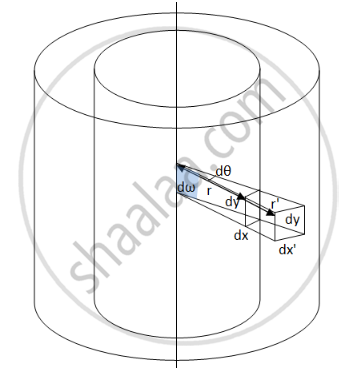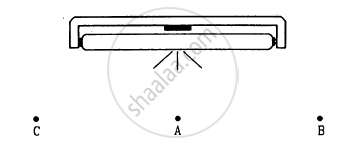Advertisements
Advertisements
प्रश्न
The intensity produced by a long cylindrical light source at a small distance r from the source is proportional to _________ .
विकल्प
\[\frac{1}{r^2}\]
\[\frac{1}{r^3}\]
\[\frac{1}{r}\]
None of these
उत्तर
\[\frac{1}{r}\]

Let us consider two coaxial cylindrical surfaces at distances r and r' from the axis. Let areas dA and dA' subtend the solid angle dω at the central axis. The height of the area element will be same, i.e. equal to dy. Let the breath of dA be dx and that of dA' be dx'.
Now from the arcs,
\[dx = rd\theta\]
\[dx' = r'd\theta\]
Now,
\[dA = dxdy = rd\theta\ dy\]
\[dA' = dx'dy = r'd\theta\ dy\]
\[\frac{dA}{dA'} = \frac{r}{r'}\]
\[ \Rightarrow \frac{dA}{r} = \frac{dA'}{r'} = d\omega\]
The luminous flux going through the solid angle dω will be
dF = Idω
Now,
\[dF = I\frac{dA}{r}\]
If the surfaces are inclined at an angle \[\alpha, \]
\[dF = I\frac{dA\cos\alpha}{r}\]
Now, illuminance is defined as
\[E = \frac{dF}{dA} = I\frac{dA\cos\alpha}{r}\]
\[ \Rightarrow E \propto \frac{1}{r}\]
APPEARS IN
संबंधित प्रश्न
Light is incident normally on a small plane surface. If the surface is rotated by an angle of 30° about the incident light, does the illuminance of the surface increase, decreases or remain same? Does your answer change if the light did not fall normally on the surface?
The sun is less bright at morning and evening as compared to at noon although its distance from the observer is almost the same Why?
Why is the luminous efficiency small for a filament bulb as compared to a mercury vapour lamp?
The yellow colour has a greater luminous efficiency as compared to the other colours. Can we increase the illuminating power of a white light source by putting a yellow plastic paper around this source?
The one parameter that determines the brightness of a light source sensed by an eye is ____________ .
An electric bulb is hanging over a table at a height of 1 m above it. The illuminance on the table directly below the bulb is 40 lux. The illuminance at a point on the table 1 m away from the first point will be about ___________ .
A battery-operated torch is adjusted to send an almost parallel beam of light. It produces an illuminancle of 40 lux when the light falls on a wall 2 m away. The illuminance produced when it falls on a wall 4 m away is close to _________ .
A photographic plate is placed directly in front of a small diffused source in the shape of a circular disc. It takes 12s to get a good exposure. If the source is rotated by 60° about one of its diameter, the time needed to get the same exposure will be ___________ .
Figure shows a glowing mercury tube. The intensities at point A, B and C are related as __________ .

A room is illuminated by an extended source. The illuminance at a particular portion of a wall can be increased by
(a) moving the source
(b) rotating the source
(c) bringing some mirrors in proper positions
(d) changing the colour of the source.
A source emits 45 joules of energy in 15 s. What is the radiant flux of the source?
A photographic plate records sufficiently intense lines when it is exposed for 12 s to a source of 10 W. How long should it be exposed to a 12 W source radiating the light of same colour to get equally intense lines?
The luminous flux of a monochromatic source of 1 W is 450 lumen watt−1. Find the relative luminosity at the wavelength emitted.
The illuminance of a small area changes from 900 lumen m−2 to 400 lumen m−2 when it is shifted along its normal by 10 cm. Assuming that it is illuminated by a point source placed on the normal, find the distance between the source and the area in the original position.
A point source emitting light uniformly in all directions is placed 60 cm above a table-top. The illuminance at a point on the table-top, directly below the source, is 15 lux. Find the illuminance at a point on the table-top 80 cm away from the first point.
Light travels through a glass plate of thickness t and having a refractive index μ. If c is the velocity of light in vacuum, the time taken by the light to travel this thickness of glass is ______.
